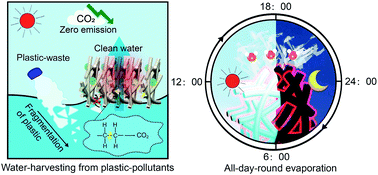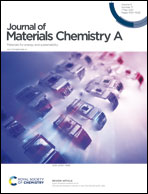A biomass-derived, all-day-round solar evaporation platform for harvesting clean water from microplastic pollution†
Abstract
Solar-driven evaporation is highly promising for sustainable freshwater production without high energy-consumption. Till now, it has still been challenging to achieve both high performance and cost-effectiveness within one evaporator. In addition, the rarely reported strategy overcomes the obstacles of emerging microplastic-pollution in water sources and poor all-day-round evaporation. Herein, a low-cost, high-efficiency, biomass-derived three-dimensional (3D) graphene/cotton sponge with gradient vertical microchannels was readily constructed by simply stretching cotton. It served as a versatile photothermal platform with a high evaporation rate (2.49 kg m−2 h−1, normalized to both the top and side surfaces) and could withstand a large external stress of up to 8750-times its weight. Moreover, in the first attempt to efficiently evaporate water (90.6%) from a microplastic-polluted source, nearly 100% of the polyethylene (PE) microfibers were removed from evaporated water by 3D MoS2/graphene/cotton via reactive oxygen species attack and multi-level interception. New in situ FTIR microscopy technology was employed to accurately monitor the degradation mechanism of the PE microplastics. The PE degradation efficiency was as high as 19% in oxygen-enriched water, predominantly contributed by reactive O2˙−, and could be easily enhanced to 32% with the aid of additional reactive species (e.g., ˙HOO and H2O2) in 1 h. Besides, under the guidance of finite element analysis (FEA), a phase-change polyethylene glycol (PEG) layer was functionalized outside the graphene/cotton. Notably, it possessed a remarkably high all-day-round evaporation rate (1.63 kg per m2 per h per day, 1.42-times that achieved by a traditional evaporator without phase-change function) by utilizing thermal energy in the dark. This work gives promising alternative strategies for low-cost clean-water harvesting from microplastic-pollution and sustainable evaporation even under dark conditions.



 Please wait while we load your content...
Please wait while we load your content...